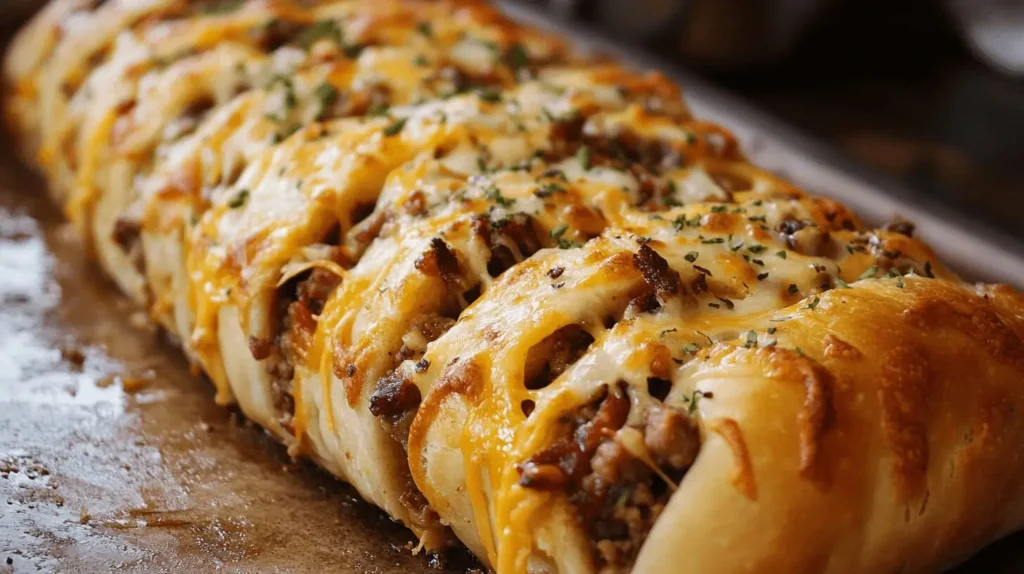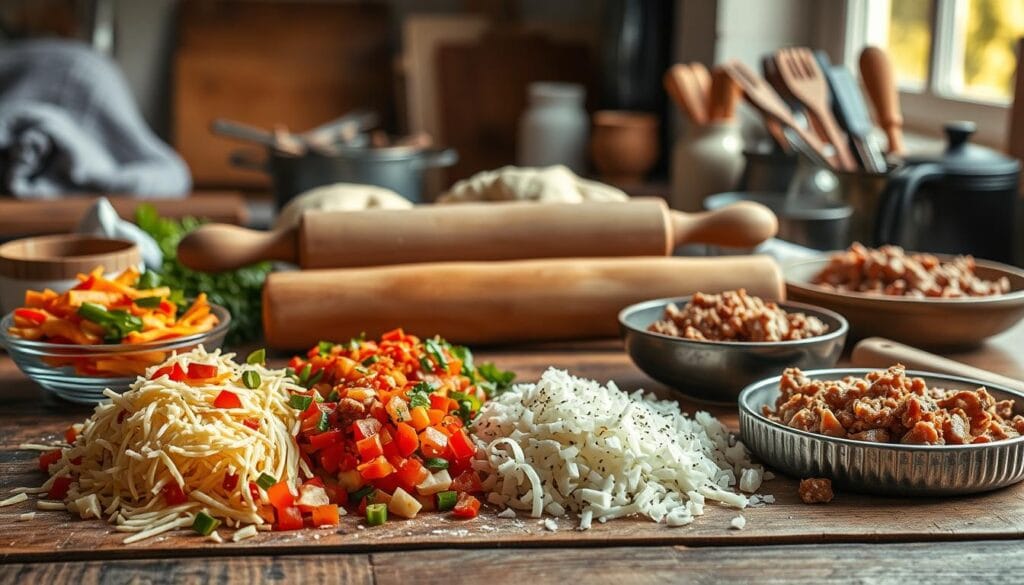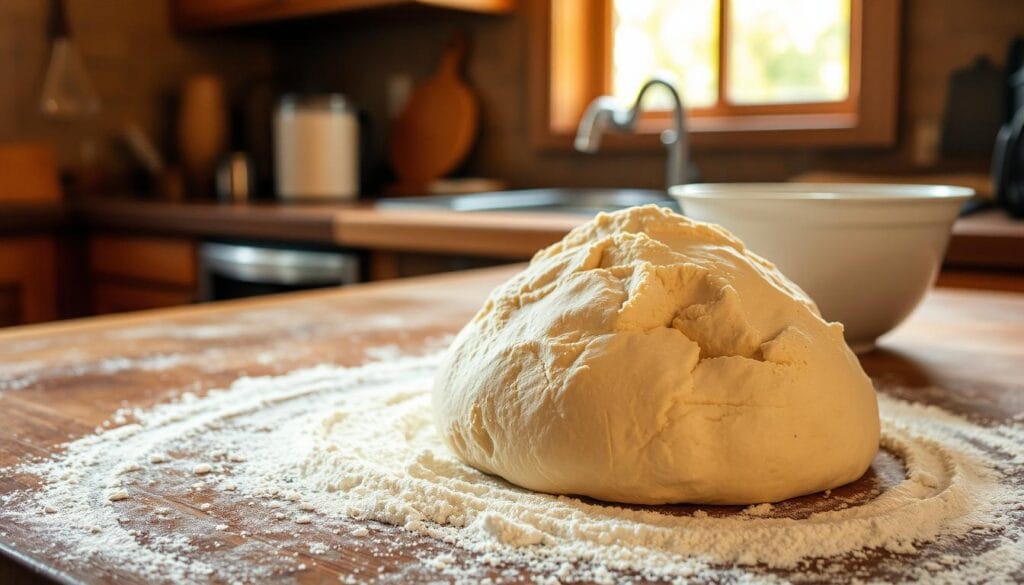Imagine a kitchen full of leftovers and a desire for something new. That’s when a garbage bread recipe comes to the rescue. It turns leftovers into a tasty meal.
Ever looked in your fridge and wondered how to mix leftovers? Garbage bread is your kitchen savior. It makes a tasty stuffed bread from random ingredients.
Recycling food waste is more than just saving the planet. It’s a fun kitchen adventure. With pizza dough and leftovers, you can make a meal that’s both smart and yummy.
This guide will show you how to make the best garbage bread. You’ll learn to pick ingredients and roll the dough. Soon, you’ll be making a dish that saves money and reduces waste. Get ready to wow your loved ones with this tasty, versatile dish.
Understanding Garbage Bread: A Comfort Food Classic
Garbage bread is a smart way to use up leftovers and stale bread. It turns simple ingredients into a tasty meal that shows off home cooking creativity.

The story of garbage bread is as fascinating as its name. Home cooks found a way to make a tasty stuffed bread from leftovers.
Origins and Evolution
Garbage bread started as a kitchen hack. Families used leftovers to make a filling meal. It’s all about:
- Culinary resourcefulness
- Budget-friendly cooking
- Creative ingredient transformation
Why It’s Called Garbage Bread
Garbage bread is far from trashy. It’s named because it uses leftover ingredients to make a tasty stuffed bread.
“One person’s kitchen scraps are another’s gourmet meal.” – Anonymous Chef
Modern Interpretations
Now, garbage bread is a beloved comfort food. Chefs and home cooks add their own twist with different fillings.
| Classic Ingredients | Modern Variations |
|---|---|
| Leftover meats | Gourmet vegetarian options |
| Stale bread | Artisan bread bases |
| Basic cheese | Specialty cheese blends |
Garbage bread is great for reducing waste or making a tasty meal. It’s practical and delicious.
Essential Ingredients and Equipment Needed
To make tasty garbage bread, you need the right stuff. This recipe uses common items and leftovers. It turns simple things into a tasty meal that cuts down on waste.

Key Ingredients
- Pizza Dough (13.8 oz / 391g)
- Ground Beef (½ lb / 227g, 80/20 fat content)
- Pepperoni (½ cup / 56g, chopped)
- Mozzarella Cheese (1 cup / 113g)
- Cheddar Cheese (½ cup / 56g, aged 6+ months)
Essential Equipment
- Baking sheet
- Parchment paper
- Rolling pin
- Mixing bowls
- Measuring cups and spoons
Zero-waste cooking means using what you have wisely. Swap out meats or cheeses with what you have at home. Try using pre-cooked proteins like Italian sausage or turkey.
| Ingredient | Quantity | Eco-Friendly Tip |
|---|---|---|
| Ground Beef | ½ lb | Use local, sustainable sources |
| Cheese | 1½ cups | Buy from local dairies |
| Pizza Dough | 13.8 oz | Make homemade to reduce packaging |
Pro Tip: Sustainable cooking is about maximizing ingredients and minimizing waste!
Your kitchen is ready for garbage bread. It’s about tasty food and caring for the planet. Choose local ingredients and use all your produce. It’s good for you and the earth.
The Perfect Base: Choosing and Preparing Your Dough
Starting with the right dough is key to making delicious garbage bread. You can show off your creativity by trying different doughs. These can turn simple ingredients into a tasty meal.

Understanding your dough options is the first step in resourceful bread making. Whether you’re new to cooking or have baking experience, the right dough is crucial. It can make your garbage bread a hit or a miss.
Store-bought vs. Homemade Dough Options
You have two main dough paths to follow:
- Store-bought pizza dough: Quick and easy
- Homemade bread dough: Total creative control
- Premade refrigerated dough: A time-saving option
Working with Different Dough Types
Each dough type needs its own handling method. Your approach will depend on the dough’s texture and how stretchy it is.
| Dough Type | Preparation Time | Difficulty Level |
|---|---|---|
| Store-bought Pizza Dough | 5-10 minutes | Easy |
| Homemade Bread Dough | 1-2 hours | Moderate |
| Refrigerated Dough | 15-20 minutes | Very Easy |
“The secret to great garbage bread is mastering your dough technique.” – Professional Chef
Pro tip: Always let cold dough rest at room temperature for 15-20 minutes. This improves its elasticity and prevents it from tearing.
Garbage Bread Recipe: Step-by-Step Instructions
Making the perfect garbage bread is about mastering a few key techniques. These techniques turn simple ingredients into a delicious meal. This frugal kitchen hack makes a tasty dish that’s also budget-friendly.
Here’s how to make garbage bread in easy steps:
- Prepare Your Ingredients
- Gather 1 can of refrigerated pizza dough
- 1/2 pound ground beef, cooked and crumbled
- 2 cups shredded cheddar cheese
- 1/4 cup cooked bacon bits
- Seasonings to taste
- Roll Out the Dough
- Spread dough into a 12×18 inch rectangle
- Use parchment paper to prevent sticking
- Ensure even thickness for consistent baking
- Layer Your Filling
- Spread ground beef evenly
- Sprinkle cheese and bacon
- Add ketchup and mustard for extra flavor
- Roll and Seal
- Carefully roll dough into a tight log
- Pinch edges to seal filling
- Brush with beaten egg for golden crust
“Cooking is about making something delicious with what you have – that’s the essence of a true frugal kitchen hack!” – Home Cook Wisdom
Bake your garbage bread at 400°F for 20-25 minutes until golden brown. Let it rest for 5 minutes before slicing. This recipe makes 6 servings, with about 421 calories per slice.
Pro tip: Try different fillings to keep your garbage bread exciting. Use leftovers to prevent food waste!
Mastering the Filling Combinations: garbage bread recipe
Turning leftovers into a tasty meal is key to sustainable cooking. Garbage bread lets you use upcycled ingredients to make something delicious. It turns waste into a culinary journey.
Your garbage bread can be a fun way to explore flavors and textures. Let’s look at some exciting fillings to boost your cooking skills.
Classic Meat and Cheese Combinations
Traditional garbage bread fillings are comforting and satisfying. Here are some favorites:
- Pepperoni and mozzarella cheese
- Ground beef with cheddar
- Ham and Swiss cheese
- Bacon and provolone
Vegetarian Alternatives
Vegetarian fillings show how upcycled ingredients can create amazing flavors:
- Roasted bell peppers and goat cheese
- Spinach and ricotta
- Mushroom and caramelized onion
- Roasted vegetable medley
Creative Fusion Ideas
Try these innovative combinations to elevate your cooking:
- Mediterranean-inspired: Hummus, olives, and sun-dried tomatoes
- Asian fusion: Teriyaki tofu and pickled vegetables
- Southwestern: Black beans, corn, and green chilies
- Indian-spiced: Curried vegetables and paneer
“Cooking is about transforming ingredients, not just following recipes.” – Unknown Chef
Great garbage bread comes from experimenting with flavors and reducing waste. Your creativity can make simple ingredients into a fantastic meal.
Pro Tips for Rolling and Shaping: garbage bread recipe
Mastering the art of rolling and shaping is key in making bread. Your garbage bread’s success depends on careful technique and frugal kitchen hacks. These tricks turn simple ingredients into a tasty meal.
Begin by preparing a clean, flat surface dusted with light flour. Roll your pizza dough into a rectangular shape. Make sure it’s about ½ inch thick. This thickness ensures even cooking and a beautiful final product.
“The secret to perfect garbage bread is in the roll and seal!” – Professional Chef
Key techniques for rolling and shaping include:
- Begin rolling from one long side, creating a tight log
- Pinch edges firmly to seal the seam completely
- Fold and tuck end edges underneath to prevent filling leakage
- Use gentle pressure to maintain dough’s structural integrity
Pro tip: Brush the rolled dough with olive oil before baking. This step makes your garbage bread golden and crispy. It takes your bread from good to exceptional.
Remember, practice makes perfect in bread making. Each try will make you better at creating this versatile, delicious dish.
Baking Techniques for Golden Perfection: garbage bread recipe
Making the perfect garbage bread needs precision and care. Your eco-friendly baking can turn this comfort dish into a masterpiece. It will reduce waste and boost flavor.
Zero-waste cooking begins with knowing your oven and ingredients. The right baking method can make your garbage bread outstanding.
Temperature and Timing Guidelines
Getting a golden crust requires careful attention to temperature and timing. Here are key tips for baking success:
- Preheat your oven to 375°F (190°C)
- Bake for 25-30 minutes
- Look for a rich, golden-brown crust
“The secret to great garbage bread is patience and precision in baking.” – Professional Chef
Achieving the Perfect Crust
Creating a delicious crust involves several eco-friendly baking techniques:
- Brush the dough with an egg wash for shine
- Sprinkle Italian seasoning for extra flavor
- Use parchment paper to prevent sticking
Your zero-waste cooking means using every ingredient and saving energy. Let the bread rest for 5 minutes after baking. This allows flavors to settle and ensures perfect slicing.
Pro tip: If your dough is cold, add an extra 5 minutes to the baking time to ensure even cooking.
Serving Suggestions and Pairings: garbage bread recipe
Turn your garbage bread into a masterpiece with creative serving ideas. This dish’s versatility lets you turn leftovers into tasty meals.
“Great food is about making memories, and garbage bread is the perfect canvas for culinary innovation!” – Chef’s Kitchen Wisdom
Here are some exciting ways to serve your garbage bread:
- Slice into thick rounds for hearty main course servings
- Cut into smaller appetizer-sized pieces for party platters
- Serve alongside complementary dipping sauces
Pairing dipping sauces with your garbage bread can make it even better:
| Sauce Type | Flavor Profile | Best Paired With |
|---|---|---|
| Marinara Sauce | Classic Tomato | Meat-based fillings |
| Garlic Butter | Rich, Savory | Vegetarian options |
| Ranch Dressing | Creamy, Herbal | Cheese and vegetable fillings |
Your garbage bread can be a sustainable culinary adventure. It turns leftovers into a dish that pleases everyone. Try new combinations to make your own special version!
Storage and Reheating Methods: garbage bread recipe
Keeping your tasty garbage bread fresh is important. It lets you enjoy it more than once. Zero-waste cooking helps you use every bit of food, reducing waste in your kitchen.
Refrigeration and Short-Term Storage
To keep your garbage bread fresh, follow these storage guidelines:
- Wrap individual slices in plastic wrap or aluminum foil
- Place wrapped slices in an airtight container
- Refrigerate for up to 3 days maximum
Freezing Instructions
Freezing is a great way to recycle food and keep your bread fresh longer:
- Cool the bread completely before freezing
- Wrap tightly in freezer-safe plastic wrap
- Place in a freezer-safe container or zip-lock bag
- Freeze for up to 2 months
Reheating Recommendations
Here’s how to make your bread crispy again:
- Preheat oven to 350°F
- Remove from freezer and thaw overnight in refrigerator
- Bake for 10-15 minutes until heated through
- Pro tip: Wrap in foil to prevent excessive drying
“Proper storage transforms leftovers from potential waste to delicious second-chance meals.” – Culinary Preservation Expert
Using these zero-waste cooking tips, you’ll get the most out of your garbage bread. And you’ll reduce kitchen waste too.
Troubleshooting Common Issues: garbage bread recipe
Making bread can be tricky, but with smart tips, you can fix most problems. Knowing common issues helps make perfect stuffed bread every time.
Dough Challenges
Working with bread dough can bring up several issues. Here are some tips to help:
- Sticky dough: Dust with extra flour gradually
- Dry dough: Add small amounts of water or olive oil
- Dough not rising: Check yeast freshness and temperature
Filling and Baking Problems
Here are ways to avoid common filling problems:
| Problem | Solution |
|---|---|
| Leaking filling | Seal edges tightly, leave small vents |
| Uneven browning | Rotate pan midway, use parchment paper |
| Soggy bottom | Preheat baking sheet, use cornmeal |
“The secret to great bread is patience and practice” – Artisan Baker
For frugal kitchen hacks, keep ingredients at room temperature. Measure precisely. Yeast works best in water between 125°F and 130°F. Modern yeast doesn’t need sugar to activate.
Pro Tips
- Use fresh ingredients
- Follow recipe measurements exactly
- Allow proper resting time
Practice makes perfect in resourceful bread making!
Variations and Creative Twists: garbage bread recipe
Turning your garbage bread recipe into a fun project is exciting. You can use upcycled ingredients and get creative in the kitchen. This turns a simple dish into a flavorful adventure.
- Mediterranean Fusion: Add sun-dried tomatoes, feta cheese, and olive tapenade
- Vegetarian Delight: Mix in roasted veggies and plant-based cheese
- Breakfast-inspired: Add scrambled eggs, bacon bits, and cheddar cheese
- Sweet Dessert Twist: Try a nutella and banana-filled version
Reducing food waste and boosting flavor is key to sustainable cooking. Here are some ideas to use up leftover ingredients:
- Use leftover roasted meats as filling
- Add vegetable scraps from previous meals
- Try cheese ends and bits
“Creativity is intelligence having fun in the kitchen!” – Unknown Culinary Enthusiast
| Variation Type | Key Ingredients | Flavor Profile |
|---|---|---|
| Mediterranean | Olives, Feta, Tomatoes | Tangy, Herbal |
| Breakfast | Eggs, Bacon, Cheddar | Rich, Savory |
| Vegetarian | Roasted Vegetables, Plant Cheese | Fresh, Hearty |
The secret to amazing garbage bread is experimentation. Feel free to mix and match ingredients to create your own unique version!
Conclusion
Garbage bread is more than a tasty meal; it’s a way to reduce waste in cooking. It turns leftovers into a delicious dish, helping you save food. This method lets you use ingredients you might throw away.
The recipe is flexible, fitting any diet or ingredient you have. It’s great for meat lovers, vegetarians, or anyone who loves trying new things. Your kitchen becomes a place of endless flavor possibilities.
Don’t worry if your first try isn’t perfect. Each time you make garbage bread, you’ll get better. It’s a chance to learn and try new things. With just 45 minutes of cooking, it’s a great dish to add to your cooking list.
This recipe is about more than just food. It’s about being green, creative, and enjoying cooking. Every time you make it, you’re part of a tradition that values both. So, start your garbage bread journey today!

